Special to Transport Topics
AI in Trucking
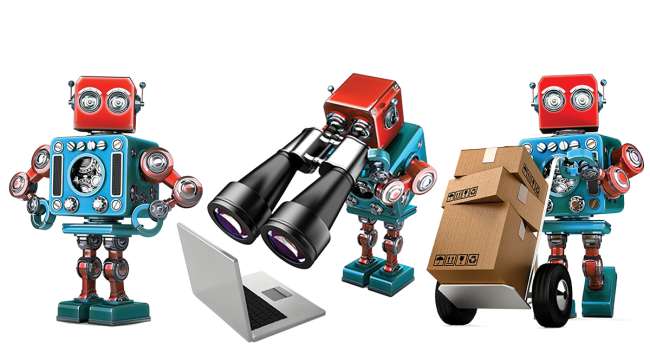
The terms artificial intelligence and automation pepper discussions about the transportation industry’s future, often closely followed by mentions of autonomous vehicles. But while self-driving trucks are still in their infancy, AI already is influencing the back office’s digital transformation.
“There’s nothing new or scary about AI, it’s just the most powerful toolkit that we, as a technology community, have created thus far,” said Parker Holcomb, co-founder and CEO of Fraight AI, a technology-enabled freight broker. The last few years in particular have brought a renewed push for AI due to factors such as the “convergence of large pools of data [and] cheaper server and computing costs,” he said.
In addition, tech giants such as Google have created readily accessible frameworks, making it easier for software-as-a-service businesses, including those specializing in transportation management software, to “build on the shoulders of giants” rather than starting from scratch, Holcomb said. “We couldn’t have done this company 10 years ago.”
He likens it to how ride-hailing pioneer Uber didn’t invent mobile apps or location-based services such as GPS, but was enabled by the convergence of those technologies. “We didn’t invent natural language processing but we are enabled by the current toolkit,” Holcomb said.
AI’s prevalence in transportation is just beginning to take hold. A report by research firm MarketsandMarkets estimates that the AI market for the transportation industry is projected to grow at a compound annual growth rate of nearly 18% from 2017 to 2030, with its size increasing from $1.2 billion in 2017 to $10.3 billion by 2030. And deep learning technologies are expected to hold the largest share of the AI in transportation market.
AI and Machine Learning
Various levels of artificial intelligence and machine learning exist even though, colloquially, the terms often are used interchangeably. Artificial intelligence is a broad term encompassing cognitive-style tasks that emulate human reasoning. The term is vague and dynamic, as evidenced by simple calculators, which once were regarded as a form of AI but generally are not anymore.
Machine learning is a branch of artificial intelligence, or rather an application of the concept, that uses algorithms to automatically improve computer functions and “cognition” with ongoing experience. It compares new data with previously inputted data to detect patterns and relationships. Deep learning is a more advanced, in-depth layer of machine learning that typically aggregates data from a more diverse variety of sources.
They all build on each other and, in a sense, could be likened to a set of Russian nesting dolls. AI is the big concept — represented by the outer doll — and each successive process it contains grows narrower in scope as the processes become more specialized — represented by subsequently smaller nesting dolls.
Different transportation software employs different levels of AI, but it all targets the same goal: to increase efficiency.
“Artificial intelligence models should be able to look at the same data points and arrive at conclusions that a properly trained [human] operator … would have arrived at, but quicker and with more consistency,” said Ben Wiesen, president of Carrier Logistics Inc., a provider of management software for the less-than-truckload industry.
Previous software iterations have required “your back office to train on it ... humans learning to speak computer,” Fraight AI’s Holcomb said. “This is the first generation of technology that trains on you. It is computers learning to speak human.”
Back-Office Automation
Transportation operations can benefit a great deal from the increased efficiency AI offers because “the back office can be a pinch point” due to all the information that passes through it on a daily basis, said Matt Bernstein, CEO of technology supplier HubTran.
Machines can alleviate that pinch point by increasing speed and productivity while reducing errors and increasing consistency.
Even with proper training, humans’ work consistency varies from day to day, and as a result of outside factors such as not getting enough sleep or having a bad day. Those human inconsistencies do not present issues for AI-enabled software. It processes data exactly as it was programmed to do, which cuts down on errors.
“Whenever you have manual processes, no matter how many checkers there are, there will be errors,” Bernstein said. “Reduction of errors is a big deal for these companies.”
Dispatchers find themselves in many situations where consistency matters, such as choosing whether to add an extra truck to the mix, call a driver back to a terminal or distribution center, call in an extra driver who has the day off or have a driver stay in an area longer hoping for a late pickup.
“These are tough decisions and have real dollar and customer satisfaction implications,” CLI’s Wiesen said.
Running a business smoothly and efficiently can reduce turnover by boosting employee satisfaction, tech experts said.
Implementing AI solutions for repetitive administrative tasks can give employees “the opportunity to work on things humans are good at and computers on things computers are good at,” said Chris Orban, vice president of data science at Trimble Transportation.
Those workers can then be moved into roles where they can apply their h-uman judgment and expertise instead of performing mundane tasks such as rekeying data.
“This is about allowing people to do things that are more productive for fleets. … Let them do extra value-add tasks,” said Hayden Cardiff, CEO of Idelic, a software firm focused on fleet safety and operations. “Administrators can turn into analysts. Clerical staff can become driver trainers. Fleets can repurpose people to jobs that are more impactful for safety and driver retention initiatives.”
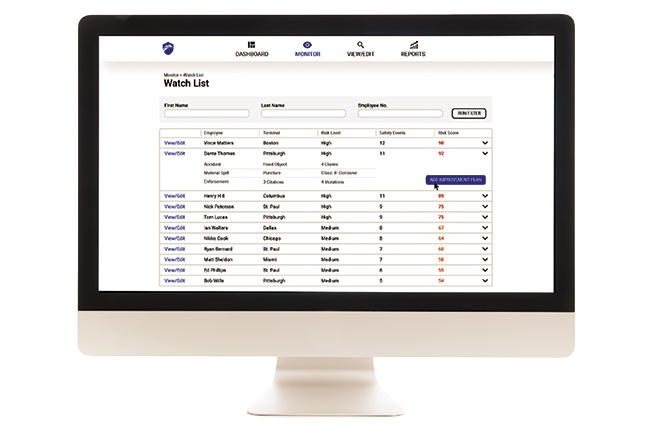
Idelic uses machine-learning algorithms to predict which drivers in a given fleet represent the highest risk for accidents and violations. Fleet managers can use that information to assign driver training. (Idelic)
And when employees feel like they’re making a difference, “that’s where they get satisfaction,” and they are more likely to stay with a company, HubTran’s Bernstein said.
Small carriers and owner-operators in particular can reap significant benefits from AI-enabled systems because “if you’re doing back-office work, you’re not growing your business,” Bernstein said. “This is an enabler for growth.”
Rather than relying on employees to search for patterns and the best way to handle thousands of business situations, AI models can just show a human operator the few outliers that could use human attention.
In short, AI can enable transportation businesses to “do more with less,” said Doug Waggoner, CEO of Echo Global Logistics, a technology-driven provider of transportation and supply chain management services.
AI in Action
Two AI functions that prove especially beneficial for the back office are natural image processing and predictive analytics. Many of the individual AI-fueled applications already in use in transportation build from those two concepts.
The industry’s adoption of new technology such as electronic logging devices has created opportunity for expanding those concepts with new types of information gathering.
“There’s so much more data. We’re getting data off the video in many vehicles and that’s a relatively new thing in last five years. ... And we’ve got ELD hours of service, which we didn’t have before,” said Lauren Domnick, chief data scientist at trucking technology vendor Omnitracs.
Natural image processing recognizes and retrieves scanned documents and the information they contain to alleviate manual data entry into a computer system. It is incorporated into software that grows increasingly better at pulling the correct data from different forms, analyzing that information and performing automated actions that traditionally would have represented hours of paperwork.
“You essentially have an infinite variety of documents,” said HubTran’s Bernstein, whose business particularly focuses on automating the payables process. “Machine learning is dynamically learning what all these documents are and how to get information out of them.”
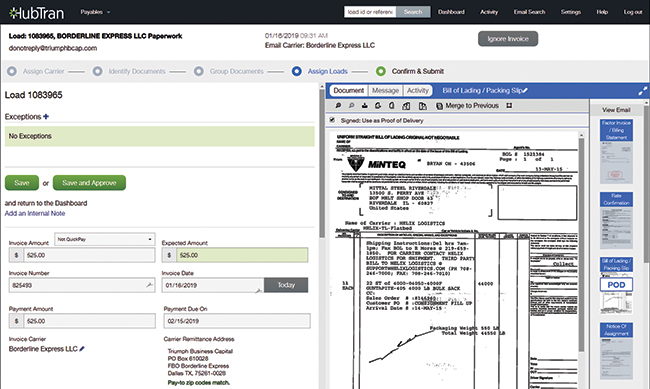
HubTran's software uses a form of artificial intelligence to automatically extract data from freight documents, which reduces labor and eliminates errors caused by manually transcribing the information. (HubTran)
Traditional billing and invoicing involves “lots of transactions, lots of rekeying, lots of manual work, and it’s a very high-cost, slow, error-prone process,” Bernstein said. But the automated system can instantaneously recognize what each document is — an invoice or a rate confirmation, for example — and it knows which company it came from and which load it belongs to. The system provides invoice verification so companies don’t “get anxious and send the same invoice two or three times ... [and] the carrier is now getting fewer duplicate invoices, inquiries and verification calls,” he said.
AI software can scale to handle additional work and industry evolutions, such as the rise of multimodal transportation, tech experts said.
In addition to increasing human efficiency, AI models can find patterns and reach conclusions that humans do not have the capacity to process. Predictive analytics is a commonly used process for identifying many of these patterns and conclusions that would be difficult for humans to recognize, due to either brain capacity or time constraints. It is used for a slew of applications that determine the probability of different events occurring.
“The human brain can’t process all these different data elements. It just can’t hold all that information at the same time. Computers can. They take this information and ... get to the right decisions quickly,” Trimble’s Orban said.
Predictive analytics can have a big effect on safety by aggregating different data to determine which drivers are most likely to get in a preventable accident or to incur a safety or compliance violation. The system analyzes a driver’s individual data over time — such as hours of service and citations — and flags potential safety trends for fleet managers or human resources.
That information not only allows a manager to identify drivers who could use additional training but also which loads best suit higher-risk drivers. For example, machine learning can identify a high-risk driver and recommend against matching that person with a high-priority load that needs to travel through challenging winter weather.
AI-Driven Optimization
Load matching and route optimization are prime examples of how computers draw information from multiple internal and external sources to find patterns that humans might not be able to detect.
A dispatcher might look at several hundred loads, but it takes a while to find the one that fits really well with a specific driver. A computer can recognize that quickly and make a better decision about driver load selection, said Dustin Strickland, product manager for McLeod Software’s LoadMaster Enterprise system.
“You might send a guy to Miami, and it’s going to be a great load, but to get out of Miami you’re going to have to deadhead him,” Strickland said. AI-enabled systems, on the other hand, allow dispatchers to better see the “forward yield consequences. ... The computer knows all that ahead of time and makes recommendations.”
Basic load-matching applications have been around for a while, but they present a prime “opportunity for improvement with the powerful machine learning algorithms that have been developed in the past five to six years [to] speed up efficiency and change how we work with the back office,” Trimble’s Orban said. Given the tight labor market in trucking, managers are showing greater interest in these applications because “if we continue to increase the accuracy of matching the right driver to the right order, customers and drivers both are happier,” he said.
With load-matching applications, “instead of spending extra time looking for freight, [humans are] getting back to more meaningful conversations with the driver. That has an impact in terms of driver satisfaction,” McLeod’s Strickland said. “When there’s a driver shortage ... you really have to go out of your way to know and understand things a driver likes ... and you want to be as accommodating as possible.”
A related AI model gaining popularity analyzes drivers’ satisfaction and their likelihood to quit. This driver-retention software compiles data that detect driver performance — HR reports, prior accidents or citations, hard braking incidents, on-time deliveries, in-cab video and in some cases, driver route preferences. The software sends managers a notification that a certain driver is at risk of terminating their employment and recommends outreach.
“Our most popular model is the retention model,” Omnitracs’ Domnick said.
Along with retention, AI can help optimize driver recruiting. The software sifts through résumés or applications quickly and suggests who recruiters should contact based on the company’s desired skills. Some software also crawls the web to search for qualified candidates and can automatically contact them for an interview; certain applications even conduct auto-interviews via text chat or video calls.
“Another use is price discovery. ... We can use pattern recognition to understand how certain shippers behave,” Echo Global Logistics’ Waggoner said. And technology companies also can build “software bots that read e-mails and understand what to do with those e-mails so humans don’t have to look at invoices from carriers.”
A big push for the transportation industry is to reduce driver detention time at shippers’ and receivers’ facilities, tech experts said. They’re using data to find potential causes and risks as well as identifying patterns that could lead to solutions.
“Detention time costs billions annually,” Omnitracs’ Domnick said. “Getting a handle on detention time is a big focus for us in 2019.”
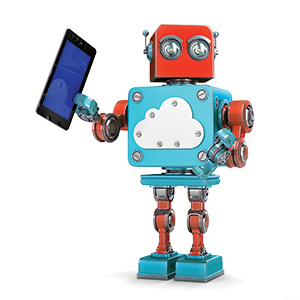
The future of machine learning includes work on developing “a universal driver score, so as drivers go from fleet to fleet, they’ll have a safety score that follows them,” Idelic’s Cardiff said.
The driver’s profile would contain data that is understood by every fleet’s computer system.
“Those kinds of things get us really excited and are in the near future,” he said.
Off-the-shelf AI systems are readily available for all transportation businesses, but software-as-a-service companies can build customized applications tailored to a fleet’s needs.
Omnitracs built a model that predicts drivers most likely to get into a worker’s compensation claim situation as well as a “fatigue model built on circadian rhythms ... looking at when a driver is on duty and off duty, and identifying risky periods when the driver is fatigued or didn’t get enough rest,” Domnick said.
The Human Touch
AI systems can optimize a variety of transportation operations, but they can’t do it all. Humans are simply better at recognizing and attending to matters that involve emotions, which are more prevalent in transportation than meets the eye, experts said.
The transportation industry is “a relationship industry built on trust and communication and what individuals need,” Holcomb said. Thus, eliminating the human element — and those human relationship-building qualities — isn’t the goal for technology developers.
Humans are, and will remain for the foreseeable future, essential for doing things the computers can’t do, experts said.
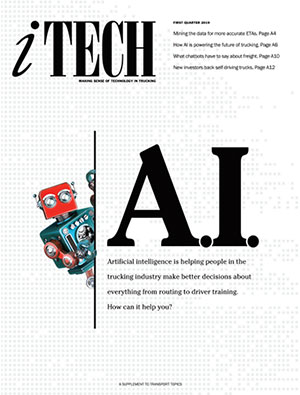
Read more iTech stories:
“[A computer] can’t empathize with the driver when they have a really frustrating experience with a customer [and] it can’t listen to the driver talk about ... their anniversary that’s coming up and say, ‘Sorry you’re going to miss your anniversary, but I promise to get you home for a full week if you can just handle this one load,’ ” Orban said.
Tech businesses also run into barriers because humans do not wish to give up control of certain functions to computers.
“One of the challenges ... is just getting folks in an organization to trust the models, to trust the data, and rely on that to make business decisions,” Domnick said.
Other challenges for advancing AI in transportation include businesses trying to do too much too fast.
“Changing to an AI environment ultimately reaps a lot of benefits, but it needs to be measured with specific goals,” Strickland said. “Customers who want to automate every single thing on the first day are rarely successful.”
While AI is like all innovation in that it has challenges, those challenges will lessen over time, experts said. With each barrier that is eliminated and each additional company that adopts AI applications comes the opportunity to analyze more data and further advance machine learning.
“This is evolving rapidly,” Domnick said. “It’s a great time to be a data geek and to be using AI and machine learning.” ³

